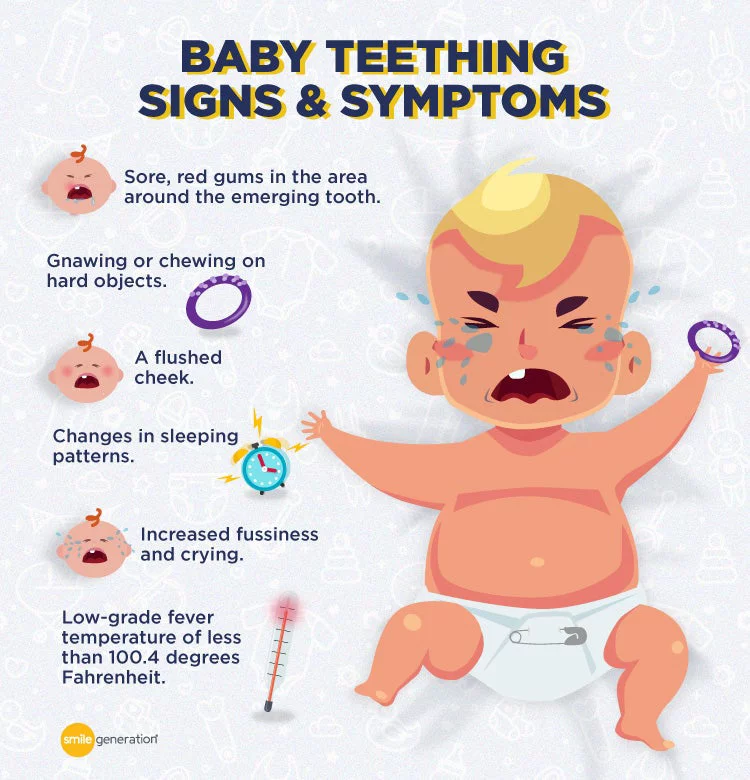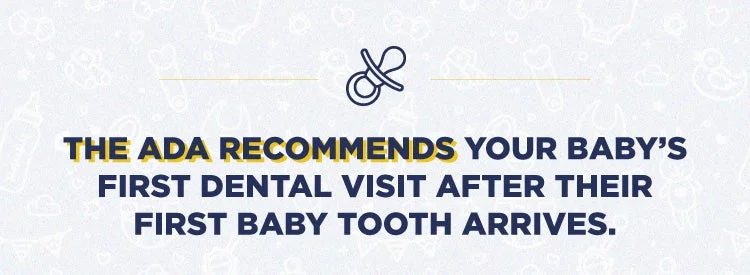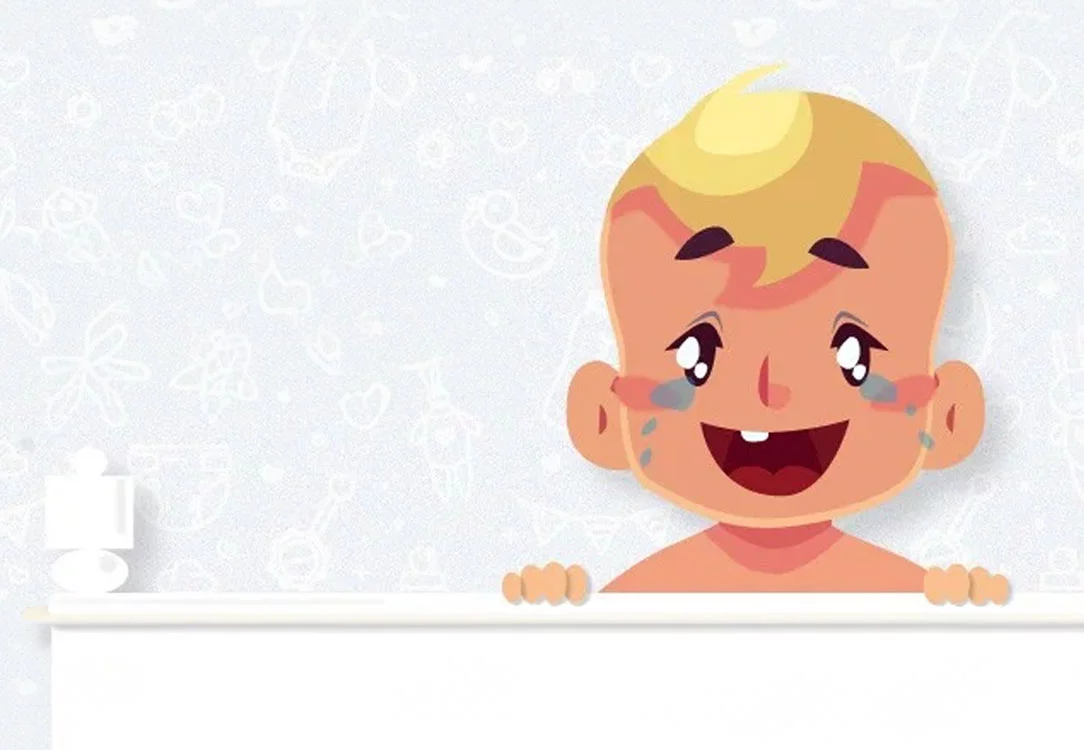What Is Baby Teething?
At birth, babies are typically born with all 20 of their baby teeth. These teeth are located beneath the gum line. Baby teething, also known as teething syndrome, happens when your baby’s teeth first emerge through their gums.
When Do Babies Start Teething?
If your baby hasn’t started teething by the time they’re around nine months old, talk to a pediatrician or pediatric dentist. While a delayed start to teething isn’t typically a cause for concern, it may sometimes be caused by certain medical or dental conditions.

Baby Teething Symptoms: What I Should I Look For?
Teething symptoms and signs can vary. For some babies, the first teeth may emerge without any pain or discomfort. For other babies, the process can be a bit more uncomfortable. Some signs baby is teething may include:
- Sore, red gums in the area around the emerging tooth.
- Low-grade fever temperature of less than 100.4 degrees Fahrenheit.
- A flushed cheek.
- Increased fussiness and crying.
- Changes in sleeping patterns.
- Gnawing or chewing on hard objects.
When to Call Your Pediatrician
If your baby is very uncomfortable during teething, call your pediatrician. They may suggest ways to soothe your baby. Also, call your pediatrician if your baby has a temperature over 100.4 degrees, a rash, or diarrhea. These symptoms aren’t typical signs of teething and could mean they have an illness that requires treatment.
Baby Teeth Chart (Eruption Timelines)
| Upper Teeth | Erupt | Lower Teeth | Erupt |
| Lower Central Incisors 🦷 | 8-12 Months ⌛ | Second Molar 🦷 | 23-31 Months ⌛ |
| Upper Central Incisors 🦷 | 9-13 Months ⌛ | First Molar 🦷 | 14-18 Months ⌛ |
| Canine (Cuspid) 🦷 | 16-22 Months ⌛ | Canine (Cuspid) 🦷 | 17-23 months ⌛ |
| First Molar 🦷 | 13-19 Months ⌛ | Lateral Incisor 🦷 | 10-16 months ⌛ |
| Second Molar 🦷 | 25-33 Months ⌛ | Central Incisor 🦷 | 6-10 months ⌛ |
Once your child’s first deciduous or baby tooth has made an appearance, you may wonder when the rest will arrive. While the timing can vary, baby teeth appear in a fairly predictable order. Looking at a baby teeth chart can help you monitor your baby’s development and see if they’re on track.

How to Soothe a Teething Baby?
Key Things to Know:
Massage gums with a clean finger or cool item for relief
Use a firm rubber teething ring—avoid unsafe materials
Ask a doctor about meds; skip numbing gels due to risks
The teething process can be difficult for you and your baby, but there are many ways to ease their discomfort.
Massage Your Baby’s Gums
Try a Teething Ring
When infants have teething pain, they may have an urge to chew on something hard. Offering a teething ring may be helpful. For safer chewing, look for a firm rubber teething ring with no small parts. Teething rings made of plastic, have small parts, or are filled with liquid could pose a potential choking hazard.
Talk to your baby's pediatrician or pediatric dentist if gum massages and teething rings aren’t enough. They may recommend a weight-appropriate dose of over-the-counter pain medicine, such as acetaminophen. The Food and Drug Administration warns parents to avoid numbing medications that are rubbed on the gums. These medications offer little benefit for teething pain because they wash away quickly and may cause serious side effects.

How Do I Care for Emergent Baby Teeth?
When Should You Start Brushing Baby Teeth?
You may wonder when to start brushing baby teeth and when to use toothpaste. Baby teeth can be brushed with toothpaste as soon as the first tooth makes its appearance. Just like your teeth, your baby’s teeth need to be brushed twice per day (morning and night). However, it’s important to use toothpaste and a toothbrush that is meant for babies.
What Baby Toothpaste Should You Use?
When shopping for your baby’s first toothpaste, look for a fluoridated baby toothpaste. These products are designed specifically for young children, who tend to prefer milder flavors than adults. Baby toothpaste may be available in a wide variety of fruity, child-friendly flavors, such as watermelon, strawberry, or banana. It may take some trial and error to find a flavor your baby likes.
Use a very small amount of toothpaste when brushing your baby’s teeth. A smear of toothpaste the size of a grain of rice is all you need. The fluoride in baby toothpaste can help prevent cavities by strengthening the outer surface of the teeth, but it’s possible to have too much of a good thing. Excess fluoride can leave white spots or other visible changes on the surface of children’s developing teeth.
When Can Babies Use Toothpaste In a Larger Quantity?
Keep brushing with just a smear of toothpaste until your child turns three. For children older than three, you can start using a pea-sized amount of toothpaste.
What Baby Toothbrush Should You Use?
For your child’s first toothbrush, look for a baby toothbrush. Baby toothbrushes have small heads that are designed to fit comfortably in infants’ mouths. They may also have wide, non-slip handles to make it easier for you to hold the brush.
The ADA recommends choosing a toothbrush with soft bristles. Compared to toothbrushes with harder bristles, they’re gentler on the gum tissue. This can help reduce the risk of gum abrasions and other gum injuries.

When Should You Take Your Child to the Dentist?
Once your baby starts teething, you may wonder: When do babies go to the dentist? The ADA recommends scheduling your baby’s first dental visit after their first baby tooth arrives. However, this first visit should happen no later than their first birthday, even if they have no teeth yet.
What Happens at a Baby’s First Dental Visit?
Your baby’s first dental visit may last around 30 to 45 minutes. The dentist may ask you to sit in the dental chair and hold your baby in your lap. This can help keep them comfortable during the appointment.
How Often Should Babies See a Dentist?
Find a Pediatric Dentist Near You
Is your baby ready for their first dental visit and you're asking where to find a trusted pediatric dentist near me. The Smile Generation makes it easy to find pediatric dentists in your area. You can use our Find a Dentist tool to search for local pediatric dental offices. You can read dentists’ bios and check out reviews from other patients, and when you find the right dentist for your child, you can book your first appointment online.
Find your trusted, local dentist today!
Sources
- American Dental Association. (n.d.). Teething. MouthHealthy. https://www.mouthhealthy.org/all-topics-a-z/teething (Accessed April 11, 2025)
- American Dental Association. (n.d.). Teething. MouthHealthy. https://www.mouthhealthy.org/en/az-topics/t/teething (Accessed April 11, 2025)
- MedlinePlus. (n.d.). Teething. U.S. National Library of Medicine. https://medlineplus.gov/ency/article/003061.htm (Accessed April 11, 2025)
- National Health Service. (n.d.). Baby teething symptoms. https://www.nhs.uk/conditions/baby/babys-development/teething/baby-teething-symptoms/ (Accessed April 11, 2025)
- American Academy of Pediatrics. (n.d.). Baby's first tooth: Facts parents should know. HealthyChildren.org. https://www.healthychildren.org/English/ages-stages/baby/teething-tooth-care/Pages/Babys-First-Tooth-Facts-Parents-Should-Know.aspx (Accessed April 11, 2025)
- American Dental Association. (n.d.). Eruption charts. MouthHealthy. https://www.mouthhealthy.org/all-topics-a-z/eruption-charts (Accessed April 11, 2025)
- Colgate. (n.d.). Teething ring safety tips. https://www.colgate.com/en-za/oral-health/kids-oral-care/teething-ring-safety-tips (Accessed April 11, 2025)
- U.S. Food and Drug Administration. (2022, February 24). Safely soothing teething pain in infants and children. https://www.fda.gov/consumers/consumer-updates/safely-soothing-teething-pain-infants-and-children (Accessed April 11, 2025)
- American Dental Association. (n.d.). Baby teeth. MouthHealthy. https://www.mouthhealthy.org/all-topics-a-z/baby-teeth/ (Accessed April 11, 2025)
- Centers for Disease Control and Prevention. (2023, August 29). About dental fluorosis. https://www.cdc.gov/oral-health/about/about-dental-fluorosis.html (Accessed April 11, 2025)
- Stanford Children’s Health. (n.d.). A child’s first dental visit fact sheet. https://www.stanfordchildrens.org/en/topic/default?id=a-childs-first-dental-visit-fact-sheet-1-1509 (Accessed April 11, 2025)
Smile Generation blog articles are reviewed by a licensed dental professional before publishing. However, we present this information for educational purposes only with the intent to promote readers’ understanding of oral health and oral healthcare treatment options and technology. We do not intend for our blog content to substitute for professional dental care and clinical advice, diagnosis, or treatment planning provided by a licensed dental professional. Smile Generation always recommends seeking the advice of a dentist, physician, or other licensed healthcare professional for a dental or medical condition or treatment.




